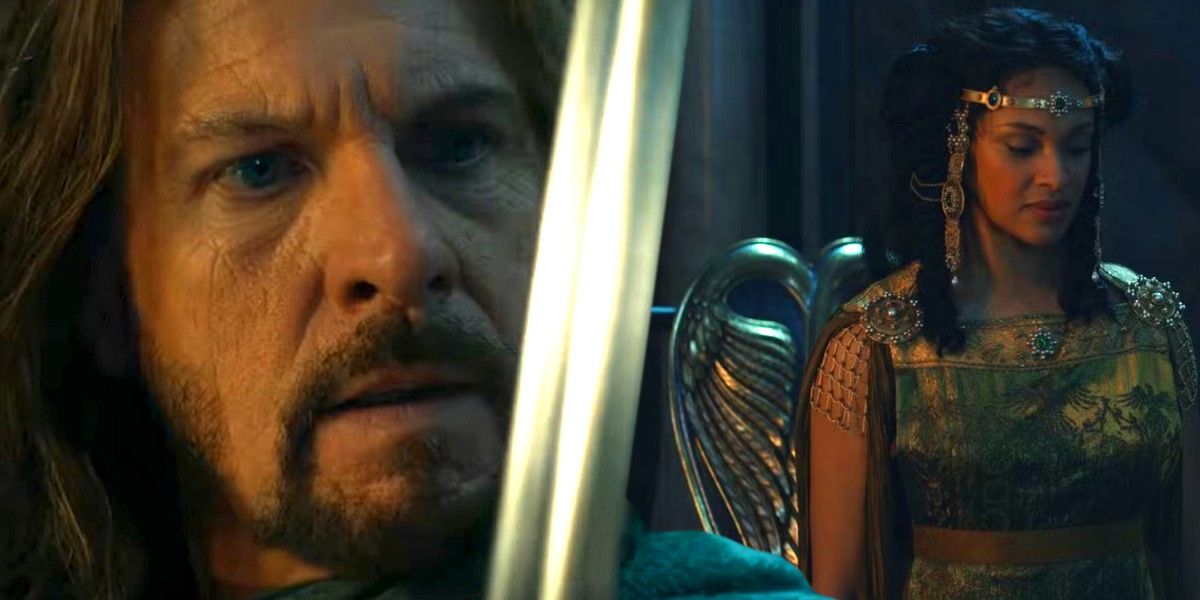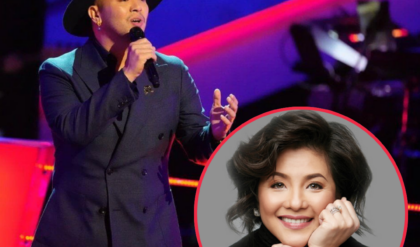
Tar-Palantir’s tower also contained a metal shield shaped like two birds, a golden battle-axe, and a masked helmet with a crest. Upon the episode’s release, fans speculated that these objects were references to lore from J. R. R. Tolkien’s writings, specifically The Silmarillion. Concept art from Wētā Workshop Design Studio later confirmed the identities of the first two, and there is a very likely candidate for the third. These items may be nothing more than Easter eggs for fans of The Lord of the Rings, but they may also become relevant in the future, just as Narsil did many episodes after its debut appearance.
The Rings of Power’s Artifacts Belonged to Ancient Heroes
The shield and axe both belonged to Tuor, the grandfather of Elrond from The Lord of the Rings. Tuor was a Man, but he was raised by Elves in the land of Mithrim. Tuor was a mighty warrior, so Ulmo, the Vala of water, believed that he could help save Middle-earth from falling under the Dark Lord Morgoth’s control. In the year 495 of the First Age — almost 3,000 years before Sauron’s defeat in the War of the Last Alliance — Ulmo sent seven white swans as a sign to Tuor. Tuor followed them toward the deserted city of Vinyamar, where he found a set of Elven arms and armor, including a shield depicting two swans. In the novel, Tuor’s shield was blue with white swans painted on it, while in The Rings of Power, the entire shield resembled two silver swans.
Tuor later traveled to the hidden Elven city of Gondolin and married its princess, Idril. During the Fall of Gondolin, Tuor fought Morgoth’s forces using an axe called Dramborleg. According to Unfinished Tales of Númenor and Middle-earth, its name meant “Thudder-Sharp,” and it was so called because it could both cut like a sword and bludgeon like a club. Tolkien did not mention Dramborleg among the equipment that Tuor found in Vinyamar, so it was presumably a weapon that he acquired in Gondolin. In one of Tolkien’s older drafts, Tuor used Dramborleg to slay five Balrogs during the Fall of Gondolin, and though Balrogs were weaker in that version of the story, it was still an impressive feat. Tuor was important to the Númenóreans because he was also the grandfather of Elrond’s brother, Elros, who gave up his Elven immortality and became the first King of Númenor.
The Rings of Power Referenced Tolkien’s Darkest Story

A helmet resembling the Dragon helm also appeared in Durin’s home in The Rings of Power.
Unlike Dramborleg and the swan shield, the helmet in Tar-Palantir’s tower was not associated with Tuor. Though Wētā Workshop did not provide a name for the helmet, most fans believe that it is meant to be the Dragon-helm of Dor-lómin, which belonged to Túrin, a different Man from the First Age. Túrin was the tragic protagonist of The Children of Húrin, a novel that expanded upon a section of The Silmarillion. Túrin’s story is infamous within Tolkien’s legendarium because it is far more grim than his other works. Túrin’s family was cursed by Morgoth, so tragedies constantly befell him and his loved ones. The Dragon-helm was an heirloom of Túrin’s house. It was a masked Dwarven helmet bearing the image of the Glaurung, Middle-earth’s first dragon. Ironically, Glaurung was Túrin’s nemesis, whom he eventually killed.
In Tolkien’s lore, Dramborleg indeed became one of the royal heirlooms of Númenor, but the other two items did not. After Túrin’s death, the Dragon-helm of Dor-lómin made its way back to his father, Húrin. Tolkien left the swan shield’s fate a mystery, but Tuor probably took it with him when he and Idril sailed to the Undying Lands. Despite deviating from the lore of the novels, the inclusions of Tuor’s swan shield and the Dragon-helm in Tar-Palantir’s tower were fun Easter eggs for attentive fans of Tolkien’s work, and it is fascinating to see Wētā Workshop’s takes on some of the most iconic weapons and armor of the First Age.




